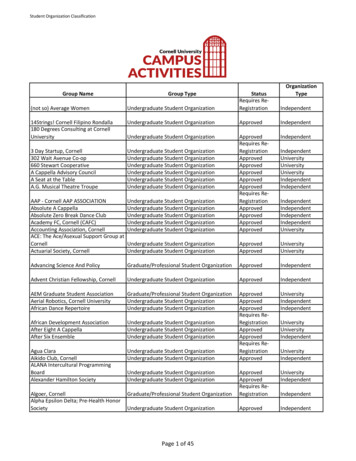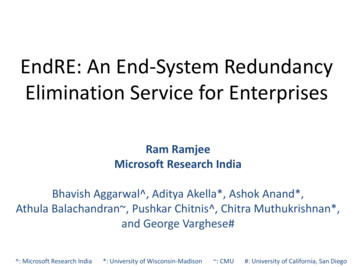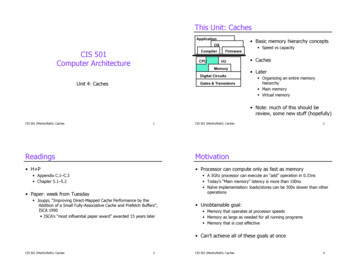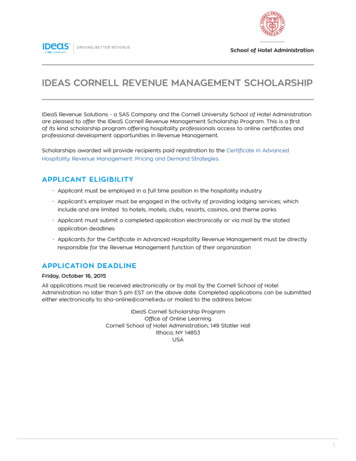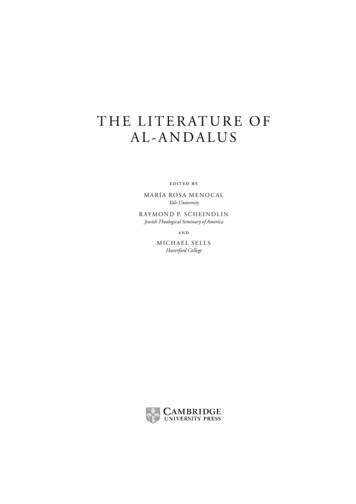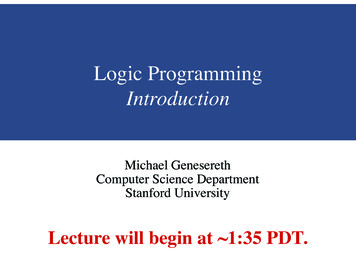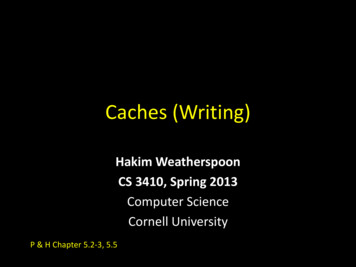
Transcription
Caches (Writing)Hakim WeatherspoonCS 3410, Spring 2013Computer ScienceCornell UniversityP & H Chapter 5.2-3, 5.5
Goals for Today: cachesWriting to the Cache Write-through vs Write-backCache Parameter TradeoffsCache Conscious Programming
Writing with Caches
EvictionWhich cache line should be evicted from the cacheto make room for a new line? Direct-mapped– no choice, must evict line selected by index Associative caches– random: select one of the lines at random– round-robin: similar to random– FIFO: replace oldest line– LRU: replace line that has not been used in the longesttime
Next GoalWhat about writes?What happens when the CPU writes to a registerand calls a store instruction?!
Cached Write PoliciesQ: How to write data?addrCPUdataCacheMemorySRAMDRAMIf data is already in the cache No-Write writes invalidate the cache and go directly to memoryWrite-Through writes go to main memory and cacheWrite-Back CPU writes only to cache cache writes to main memory later (when block is evicted)
What about Stores?Where should you write the result of a store? If that memory location is in the cache?– Send it to the cache– Should we also send it to memory right away?(write-through policy)– Wait until we kick the block out (write-back policy) If it is not in the cache?– Allocate the line (put it in the cache)?(write allocate policy)– Write it directly to memory without allocation?(no write allocate policy)
Write Allocation PoliciesQ: How to write data?addrCPUdataCacheMemorySRAMDRAMIf data is not in the cache Write-Allocate allocate a cache line for new data (and maybe write-through)No-Write-Allocate ignore cache, just go to main memory
Next GoalExample: How does a write-through cache work?Assume write-allocate.
Handling Stores (Write-Through)Using byte addresses in this example! Addr Bus 5 bitsProcessorAssume write-allocatepolicyLBLBSBSBLBSBSB 1 M[ 2 M[ 2 M[ 1 M[ 2 M[ 1 M[ 1 M[ 0 1 2 3170510510]]]]]]]CacheFully Associative Cache2 cache lines2 word block4 bit tag field1 bit block offset fieldV tag data00Misses: 1621731821332819200210225
Write-Through (REF 1)ProcessorLBLBSBSBLBSBSB 1 M[ 2 M[ 2 M[ 1 M[ 2 M[ 1 M[ 1 M[ 0 1 2 3Cache170510510]]]]]]]MemoryV tag data00Misses: 1821332819200210225
How Many Memory References?Write-through performanceEach miss (read or write) reads a block from memEach store writes an item to memEvictions don’t need to write to mem
TakeawayA cache with a write-through policy (and writeallocate) reads an entire block (cacheline) frommemory on a cache miss and writes only theupdated item to memory for a store. Evictions donot need to write to memory.
Next GoalCan we also design the cache NOT write allstores immediately to memory? Keep the most current copy in cache, and updatememory when that data is evicted (write-backpolicy)
Write-Back Meta-DataVDTagByte 1Byte 2 Byte NV 1 means the line has valid dataD 1 means the bytes are newer than main memoryWhen allocating line: Set V 1, D 0, fill in Tag and DataWhen writing line: Set D 1When evicting line: If D 0: just set V 0 If D 1: write-back Data, then set D 0, V 0
Write-back ExampleExample: How does a write-back cache work?Assume write-allocate.
Handling Stores (Write-Back)Using byte addresses in this example! Addr Bus 5 bitsProcessorAssume write-allocatepolicyLBLBSBSBLBSBSB 1 M[ 2 M[ 2 M[ 1 M[ 2 M[ 1 M[ 1 M[ 0 1 2 3170510510]]]]]]]CacheFully Associative Cache2 cache lines2 word block3 bit tag field1 bit block offset fieldV d tag data00Misses: 1621731821332819200210225
Write-Back (REF 1)ProcessorLBLBSBSBLBSBSB 1 M[ 2 M[ 2 M[ 1 M[ 2 M[ 1 M[ 1 M[ 0 1 2 3Cache170510510]]]]]]]MemoryV d tag data00Misses: 1821332819200210225
How Many Memory References?Write-back performanceEach miss (read or write) reads a block from memSome evictions write a block to mem
How Many Memory references?Each miss reads a blockTwo words in this cacheEach evicted dirty cache line writes a block
Write-through vs. Write-backWrite-through is slower But cleaner (memory always consistent)Write-back is faster But complicated when multi cores sharing memory
TakeawayA cache with a write-through policy (and writeallocate) reads an entire block (cacheline) frommemory on a cache miss and writes only the updateditem to memory for a store. Evictions do not need towrite to memory.A cache with a write-back policy (and write-allocate)reads an entire block (cacheline) from memory on acache miss, may need to write dirty cacheline first.Any writes to memory need to be the entire cachelinesince no way to distinguish which word was dirty withonly a single dirty bit. Evictions of a dirty cachelinecause a write to memory.
Next GoalWhat are other performance tradeoffs betweenwrite-through and write-back?How can we further reduce penalty for cost ofwrites to memory?
Performance: An ExamplePerformance: Write-back versus Write-throughAssume: large associative cache, 16-byte linesfor (i 1; i n; i )A[0] A[i];for (i 0; i n; i )B[i] A[i]
Performance TradeoffsQ: Hit time: write-through vs. write-back?Q: Miss penalty: write-through vs. write-back?
Write BufferingQ: Writes to main memory are slow!A: Use a write-back buffer A small queue holding dirty lines Add to end upon eviction Remove from front upon completionQ: What does it help?A: short bursts of writes (but not sustained writes)A: fast eviction reduces miss penalty
Write-through vs. Write-backWrite-through is slower But simpler (memory always consistent)Write-back is almost always faster write-back buffer hides large eviction cost But what about multiple cores with separate cachesbut sharing memory?Write-back requires a cache coherency protocol Inconsistent views of memory Need to “snoop” in each other’s caches Extremely complex protocols, very hard to get right
Cache-coherencyQ: Multiple readers and writers?A: Potentially inconsistent views of memoryCPUCPUCPUA’A CPUAL1 L1 AL1 L1 L1 L1 L1 L1AL2L2netAMemdiskCache coherency protocol May need to snoop on other CPU’s cache activity Invalidate cache line when other CPU writes Flush write-back caches before other CPU reads Or the reverse: Before writing/reading Extremely complex protocols, very hard to get right
TakeawayA cache with a write-through policy (and write-allocate) reads anentire block (cacheline) from memory on a cache miss and writesonly the updated item to memory for a store. Evictions do notneed to write to memory.A cache with a write-back policy (and write-allocate) reads anentire block (cacheline) from memory on a cache miss, may needto write dirty cacheline first. Any writes to memory need to bethe entire cacheline since no way to distinguish which word wasdirty with only a single dirty bit. Evictions of a dirty cachelinecause a write to memory.Write-through is slower, but simpler (memory always consistent)/Write-back is almost always faster (a write-back buffer can hideelarge eviction cost), but will need a coherency protocol tomaintain consistency will all levels of cache and memory.
Cache Design Tradeoffs
Cache DesignNeed to determine parameters: Cache sizeBlock size (aka line size)Number of ways of set-associativity (1, N, )Eviction policyNumber of levels of caching, parameters for eachSeparate I-cache from D-cache, or Unified cachePrefetching policies / instructionsWrite policy
A Real ExampleDual-core 3.16GHz Intel dmidecode -t cacheCache InformationConfiguration: Enabled, Not Socketed, Level 1Operational Mode: Write BackInstalled Size: 128 KBError Correction Type: NoneCache InformationConfiguration: Enabled, Not Socketed, Level 2Operational Mode: Varies With Memory AddressInstalled Size: 6144 KBError Correction Type: Single-bit ECC cd /sys/devices/system/cpu/cpu0; grep acache/index0/ways of associativity:8cache/index0/number of sets:64cache/index0/coherency line che/index1/type:Instructioncache/index1/ways of associativity:8cache/index1/number of sets:64cache/index1/coherency line che/index2/type:Unifiedcache/index2/shared cpu list:0-1cache/index2/ways of associativity:24cache/index2/number of sets:4096cache/index2/coherency line size:64cache/index2/size:6144K(purchased in 2011)
A Real ExampleDual-core 3.16GHz IntelDual 32K L1 Instruction caches 8-way set associative 64 sets 64 byte line sizeDual 32K L1 Data caches Same as aboveSingle 6M L2 Unified cache 24-way set associative (!!!) 4096 sets 64 byte line size4GB Main memory1TB Disk(purchased in 2009)
Basic Cache OrganizationQ: How to decide block size?
Experimental Results
TradeoffsFor a given total cache size,larger block sizes mean . fewer linesso fewer tags (and smaller tags for associative caches)so less overheadand fewer cold misses (within-block “prefetching”)But also fewer blocks available (for scattered accesses!) so more conflicts and larger miss penalty (time to fetch block)
Cache Conscious Programming
Cache Conscious Programming// H 12, W 10int A[H][W];for(x 0; x W; x )for(y 0; y H; y )sum A[y][x];
Cache Conscious Programming// H 12, W 10int A[H][W];for(y 0; y H; y )for(x 0; x W; x )sum A[y][x];
SummaryCaching assumptions small working set: 90/10 rule can predict future: spatial & temporal localityBenefits (big & fast) built from (big & slow) (small & fast)Tradeoffs:associativity, line size, hit cost, miss penalty, hit rate
SummaryMemory performance matters! often more than CPU performance because it is the bottleneck, and not improving much because most programs move a LOT of dataDesign space is huge Gambling against program behavior Cuts across all layers:users programs os hardwareMulti-core / Multi-Processor is complicated Inconsistent views of memory Extremely complex protocols, very hard to get right
AdministriviaPrelim1: TODAY, Thursday, March 28th in evening Time: We will start at 7:30pm sharp, so come earlyTwo Location: PHL101 and UPSB17 If NetID ends with even number, then go to PHL101 (Phillips Hall rm 101)If NetID ends with odd number, then go to UPSB17 (Upson Hall rm B17)Closed Book: NO NOTES, BOOK, ELECTRONICS, CALCULATOR, CELL PHONEPractice prelims are online in CMSMaterial covered everything up to end of week before spring break Lecture: Lectures 9 to 16 (new since last prelim)Chapter 4: Chapters 4.7 (Data Hazards) and 4.8 (Control Hazards)Chapter 2: Chapter 2.8 and 2.12 (Calling Convention and Linkers), 2.16 and 2.17(RISC and CISC)Appendix B: B.1 and B.2 (Assemblers), B.3 and B.4 (linkers and loaders), and B.5and B.6 (Calling Convention and process memory layout)Chapter 5: 5.1 and 5.2 (Caches)HW3, Project1 and Project2
AdministriviaNext six weeks Week 9 (Mar 25): Prelim2Week 10 (Apr 1): Project2 due and Lab3 handoutWeek 11 (Apr 8): Lab3 due and Project3/HW4 handoutWeek 12 (Apr 15): Project3 design doc due and HW4 dueWeek 13 (Apr 22): Project3 due and Prelim3Week 14 (Apr 29): Project4 handoutFinal Project for class Week 15 (May 6): Project4 design doc due Week 16 (May 13): Project4 due
to write dirty cacheline first. Any writes to memory need to be the entire cacheline since no way to distinguish which word was dirty with only a single dirty bit. Evictions of a dirty cacheline cause a write to memory. Write-through is slower, but simpler (memory always consistent)/ Write-back is almost always faster (a write-back buffer can hidee
